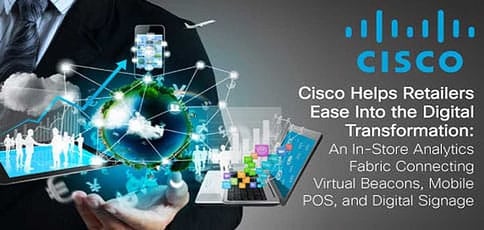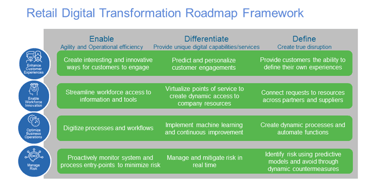
TL; DR: When a business wants to improve the customer’s experience, it often finds that the latest technology cannot be supported by its current infrastructure. But buying new hardware isn’t enough; retailers need a comprehensive plan of attack. Cisco helps lay a foundation through its digital transformation roadmap that shows a company exactly what infrastructure is needed at each step. From IT efficiency to brand differentiation to disruptive business models, Cisco builds the networks retailers need to support a future where virtual beacons, mobile point-of-sale devices, and interactive digital signage create engaging interactions.
Sometimes, retail growth leads to an inevitable face-off between IT and marketing teams. Marketing specialists are always looking for the latest digital technology to both understand customer behavior and increase engagement. But IT teams, concerned about functionality and security, often have to deny those upgrade requests because of the limits of a company’s infrastructure.
As the Senior Director of Global Consumer Industries for the Digital Transformation Group at Cisco, Ed Jimenez has seen the disconnect firsthand while consulting with retailers.
“I was working with the CIO of a major general merchandiser, and he felt like he was in the business of saying ‘No,’” Ed told us. “His business partners would go out and see new technology, like mobile point-of-sale devices or beautiful high-definition screens, and come back and want to implement them. But he would have to explain that their network was not built to scale up and handle those products.”

We spoke with Ed Jimenez, Cisco’s Senior Director of Global Consumer Industries for the Digital Transformation Group.
As one of the world leaders in IT, Cisco helps companies build the right digital framework so they can say “Yes” to new technologies on the cutting edge of both consumer engagement and analytics. But solving that disconnect takes more than throwing money at infrastructure; it takes a comprehensive plan.
Cisco has not only created the plan but also innovated the products retailers need to solidify a digital foundation scalability and incorporation of future technologies.
In-Store Success Begins with a Strong Digital Foundation
With the right infrastructure in place, the possibilities for data analysis and building the customer experience are nearly endless, and Cisco has developed a roadmap for retailers that allows them to understand what they need to build and how to ensure its scalability.
“We talk to retailers about what infrastructure they need over time to support and enable their business,” Ed said.
Cisco calls it a Digital Network Architecture, and areas like security, wifi, and data centers lay the groundwork for IT flexibility. This digital transformation roadmap is separated into three sections which represent the progression of business, with each needing the proper support.
“We developed a framework for retailers to think about their portfolio of investments,” Ed said. “We show them how to differentiate and be truly transformative with new business models and new services while still enabling core business processes.”

Cisco’s digital transformation roadmap helps retailers see what infrastructure they need to keep growing.
The first stop on the roadmap is enabling IT agility and operational efficiency, which can support technology such as smart buildings, virtual employee training, mobile point-of-sale devices, and interactive kiosks. Some of the practices and technologies in this category are already commonplace, but still need to be running on the proper infrastructure to be effective.
As companies move forward, Cisco helps them differentiate their brand by providing unique digital services like self-service, seamless returns, and promotion and layout optimization. These technologies are highly dependent on a strong network and require beacons, sensors, and other hardware to run properly.
The final stage of Cisco’s digital transformation roadmap is defining new business models and strategies. While augmented reality, automation, and digital factories aren’t yet the norm, they soon will be, and Cisco is building the connected infrastructure that will make them a reality.
The roadmap also addresses innovating employee productivity. Cisco found that 46% of retailers’ investments were going toward customer experience, but they were only investing 9% in employee production. Ed explained the real value driver for companies is actually on the employee side.
“The biggest areas of opportunity came through employee productivity,” he said. “If we can provide thousands of employees with digital capabilities, retailers can capitalize on that value.”
Empowering associates, regional managers, or district managers with mobile tools — like a dashboard to leverage location information in real time — also helps customer experience investments pay even higher dividends. That is why Cisco built its long-term roadmap with employee productivity in mind.
By weaving together an analytics fabric, Cisco is prepared to help businesses of any size scale up well into the future, whatever it may hold. As long as a retailer’s infrastructure is built correctly, there are no limits to the transformative possibilities.
Track Store Flow and Analytics by Leveraging Wifi Access Points
Wireless beacons have become the hot technology for engaging with and tracking consumers within a store, but they come with many limitations. Beacon hardware must be physically placed, meaning that each store has to manage placement, manually connect them to the system, and perform individual maintenance or replacement of each unit.
As retailers try to connect with consumers using data to assess real-time, in-store traffic — such as how many people are visiting a certain department — beacon hardware can produce plenty of blind spots. But Cisco has developed a way to transform wifi access points into virtual beacons — managed in the cloud — that can track consumers without the hassle of additional physical hardware. Virtual beacons, also known as software defined beacons, use hyperlocation to pinpoint a mobile device down to one meter, and digital zones can be constructed in different areas of a store.
“Now, a retailer can see how many customers are making it to a particular department or any specific zone,” Ed explained. “So they can tell if the problem is attracting traffic, directing traffic to certain areas of the store where there are higher margins, or simply conversions.”
The software beacons improve upon the physical versions because they are adaptable, scalable, and more accurate — and they don’t need maintenance.
“You can move it around easily, and there’s no hardware to manage, technical support, or batteries to swap out,” said Ed. “A retailer can even manage a beacon from the corporate office and see how many people are coming to a specific endcap.”
But the responsive software defined beacons go well beyond tracking customers; they can help customers find their way around a store similar to GPS, and facilitate more precise engagement with mobile consumers.
Improved Mobile Touchpoints and Digital Signage Drive Engagement
The battle for a consumer’s attention doesn’t end when they enter a store, in fact, that can be just the beginning. With the entire internet available on a mobile device, many consumers virtually exit the store to look up product reviews and deals.
Many businesses have developed dedicated apps with functions for consumers to use while in the store, but, according to Ed, they haven’t gained much traction.
“We found that an average of 5% of consumers actually use a dedicated app while in a store,” Ed told us. “The highest recorded app engagement rate was 15%, so we created ways for retailers to interact with that other 85%.”
Leveraging Cisco’s Mobile Services Platform, retailers make it possible for consumers to interact with digital signage and even be notified of deals and savings around them without having to download an app. The engagement happens over wifi, so if a customer’s mobile device is connected in-store, a retailer gets out in front of any other content they might browse.
Retailers work hard to keep consumers engaged while shopping, and Cisco is focused on eliminating barriers that can hinder that engagement.
Cisco Helps Remove Friction from the Customer Experience
Technology is continually evolving to enhance the customer experience, but the lack of proper infrastructure can hold many retailers back from leveraging those innovations. With a connected foundation from Cisco, a CIO can say “Yes” to new digital experiences when they are requested by the marketing team.
The foundation Cisco helps retailers build is vital because many innovations and future strategies will depend on it.
“Cisco serves as a core part of a business, so a lot of the investments they make will actually touch our infrastructure,” Ed said. “And we are there to help when they want to scale to support that technology.”
The company also provides plenty of guidance along the way because the end goal is to create a seamless consumer experience that feels natural. Leveraging infrastructure to analyze traffic, boost consumer engagement, and make employees more productive is all part of Cisco’s plan.
HostingAdvice.com is a free online resource that offers valuable content and comparison services to users. To keep this resource 100% free, we receive compensation from many of the offers listed on the site. Along with key review factors, this compensation may impact how and where products appear across the site (including, for example, the order in which they appear). HostingAdvice.com does not include the entire universe of available offers. Editorial opinions expressed on the site are strictly our own and are not provided, endorsed, or approved by advertisers.
Our site is committed to publishing independent, accurate content guided by strict editorial guidelines. Before articles and reviews are published on our site, they undergo a thorough review process performed by a team of independent editors and subject-matter experts to ensure the content’s accuracy, timeliness, and impartiality. Our editorial team is separate and independent of our site’s advertisers, and the opinions they express on our site are their own. To read more about our team members and their editorial backgrounds, please visit our site’s About page.

